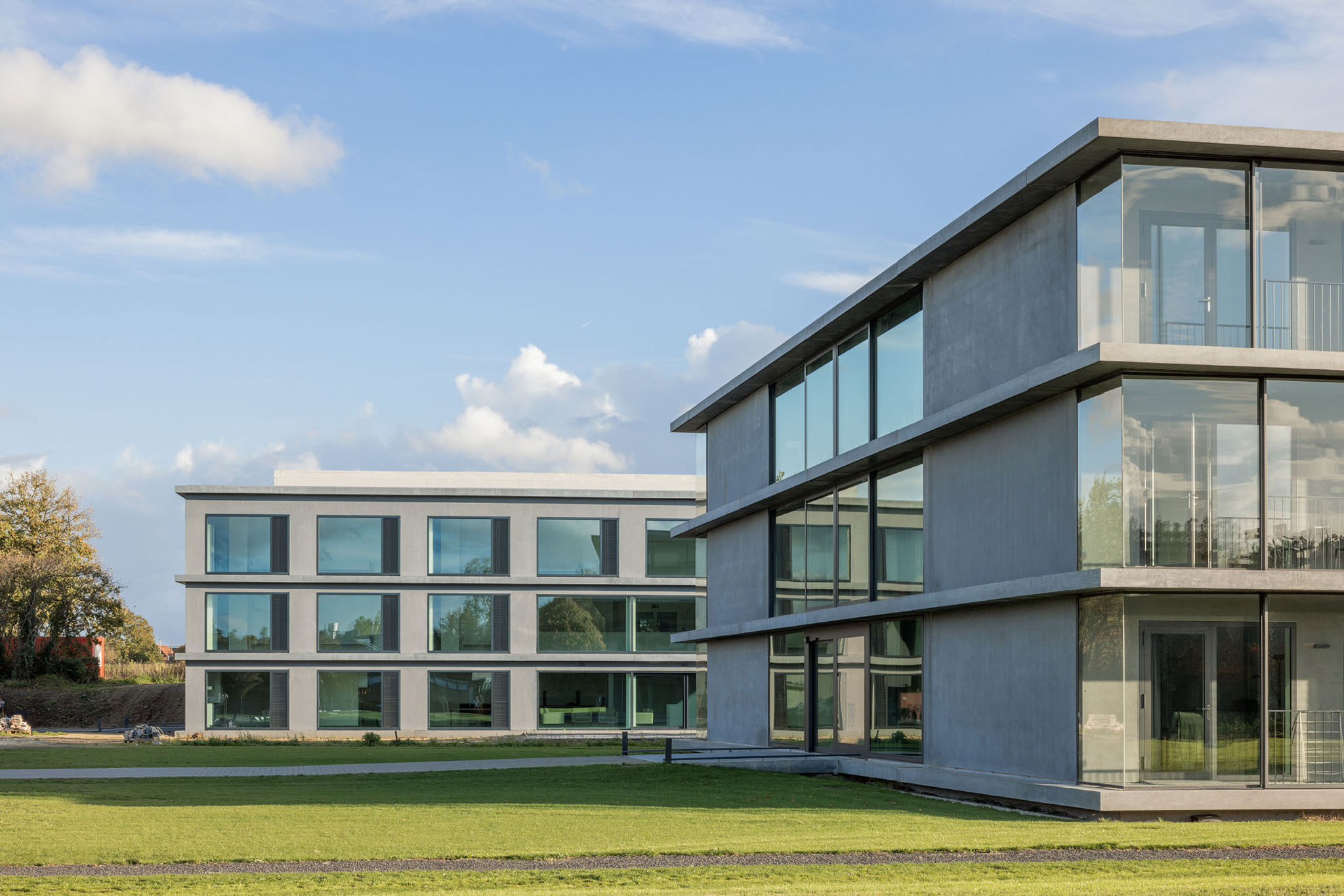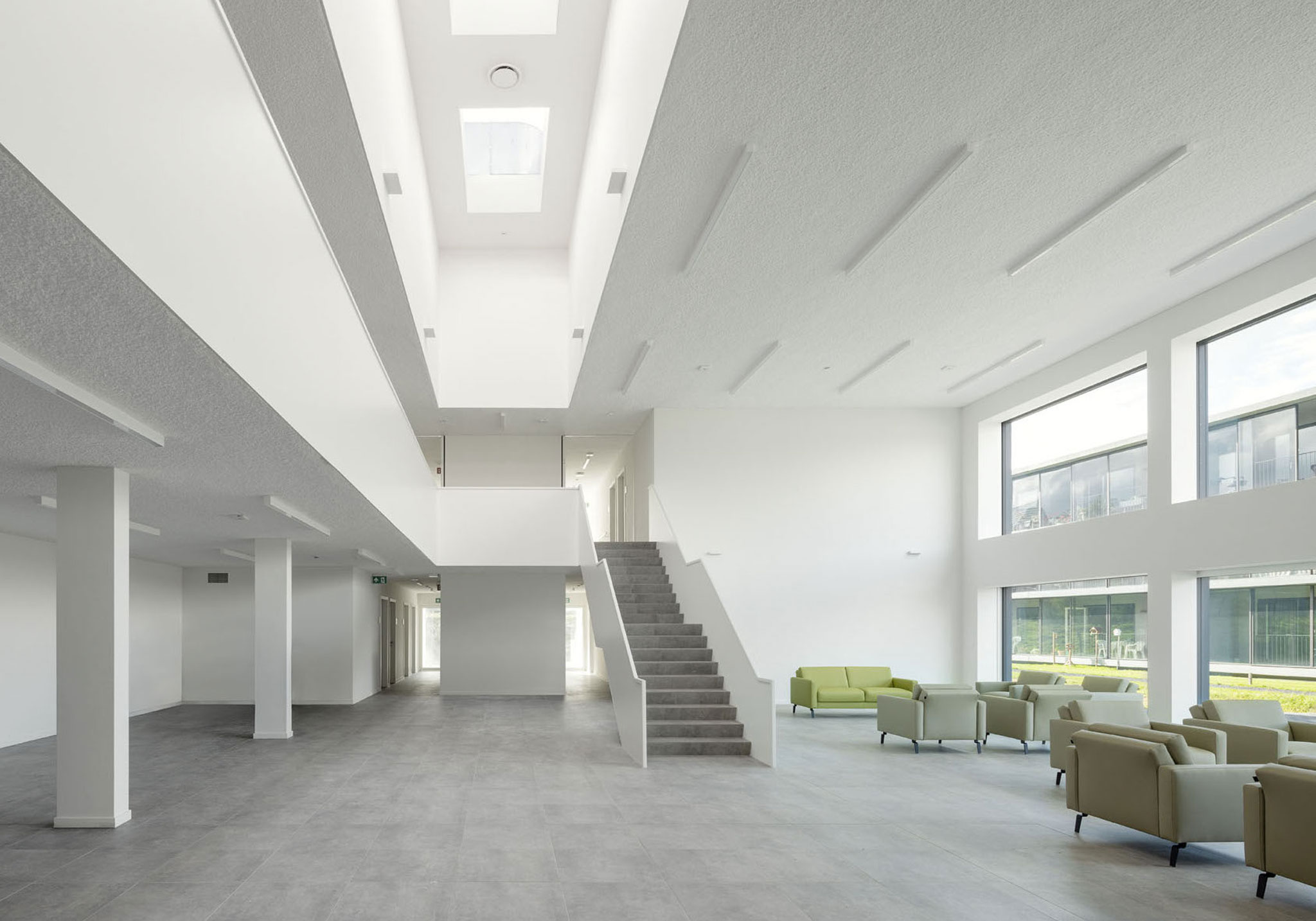The building emphasizes the horizontality of the Flemish landscape and is organized with two infrastructure cores on three floors. All common functions are located on the ground floor of the building, at the same height as the campus. Auxiliary functions that do not require natural light are integrated into the slope. Thanks to this, a spacious collective living room six meters high is generated, which forms the spatial and social centre of the typology.
It is illuminated both from above by an elongated central atrium and from the side as a result of the generous glass façade on the west side, which has a sliding door directly connected to the communal terrace. All the housing units are 24 m² located on the first and second floors and are respectively oriented to the east or west.

Psychiatric Care Home by Atelier Kempe Thill and Daniel Van Doorslaer. Photograph by Ulrich Schwarz, Architektur-Fotografie.

Project description by Atelier Kempe Thill
Urban Development Consisting of Atrium Buildings
The project in Heist-op-den-Berg is part of a master plan that Atelier Kempe Thill developed in collaboration with Daniel van Doorslaer in 2012 following a competition procedure. The master plan for the new health campus expands an existing nursing home from the 1980s and consists of a series of compact atrium buildings that are able to accommodate various living programs for different care concepts. On the one hand, the master plan takes up the urban development granularity of the rather village-like context of Heist-op-den-Berg, and on the other offers a model with great flexibility with respect to phasing, financing, and programming. The aim of the master plan is the development of economically optimized and spatially attractive buildings that have an individual, project-specific appeal, but nonetheless form a coherent complete ensemble as a whole. The architecture should thus be given a rather reserved, all-around character and emphasize the horizontality of the Flemish landscape in particular. The PVT Psychiatric Care Home is the second phase of construction within the new master plan. The project aims to stimulate psychiatric patients to live more self-determined life and facilitate the reintegration of the residents into society. To this end, numerous support and leisure offerings are provided within the project. The building offers thirty-one individual small residential units and a range of communal functions.
Atrium Building and Collective Living Room
The building is situated on the eastern edge of the master plan, on a plot of land along a small, more elevated access road with a height difference of more than two meters to the campus itself. The building is organized as a compact atrium building typology with two infrastructure cores over three stories and is built into the newly structured hillside. All the communal functions are found on the ground floor of the building, at the same elevation as the campus. Auxiliary functions that require no daylight are thus integrated into the hillside. The building is therefore designed so that a six-meter-high, spacious collective living room forms the spatial and social centre of the typology. It is illuminated both from above by a central, elongated atrium and from the side as a result of the generous glass façade on the western side, which has a sliding door directly connected to the communal terrace. The internal development of the ground floor and the first floor, which are connected with one another via a freestanding flight of stairs, is integrated into the living room in an open manner. The leap in elevation on the plot of land is thus also translated into an inspiring spatial concept within the building, and thus reinforces the feeling of community as well as the social interaction of the residents. All the living units are accommodated on the first and second stories and are respectively oriented toward the east or west. They are only 24m2 in size but equipped with a kitchenette and bathroom. All the units have very generous glazing, whereby the green, village-like surroundings expand the interior optically and present the landscape like a painting. As a result, the small living units also seem more spacious and relaxed.

Psychiatric Care Home by Atelier Kempe Thill and Daniel Van Doorslaer. Photograph by Ulrich Schwarz, Architektur-Fotografie.
Horizontality and Symmetry
The building also addresses the variation in elevation of the plot of land in its external appearance. The façade consists of clearly readable levels, which are emphasized by means of projecting horizontal bands of concrete. The eastern façade toward the street has two stories and forms a raised ground-floor mezzanine so as to offer sufficient privacy for the living units on the first floor. The entrance to the street is positioned in the centre of the façade and is accessed via an external staircase. From here, a sight axis through the entire building opens up. The western façade has three stories and is positioned nearly at ground level. The symmetrically positioned living room, with its height of two stories and the terrace in front of it, forms a central element in the façade. The southern and northern façades are generally rather closed but are glazed with large panes in the access area. All the living units are furnished with the same type of window. Generous fixed glazing with integrated sun protection screens is combined with one wing that can be opened, which is equipped with a metal grille on the outside as protection against falls.
An Economy of Means
The building is intentionally organized in a simple manner in order to be able to offer a maximum living quality for users within the rather tight budget of a publicly funded project. The basis for the organization is an economically optimized typology with great compactness, as well as a standardized building structure that facilitates simple industrial construction. The building is thus constructed from glued-together, vertical lime-sand block elements and filigree ceilings. In the area of the large living room, the façade and part of the upper wall of the corridor are executed as load-bearing concrete elements so as to facilitate the larger spans. The façade is defined by the projecting bands of concrete, which also serve as a fire-protection element in the façade. They are produced from prefabricated components with smooth, white exposed concrete with an additive of black pigment. The façade also has a dark grey, plastered thermal insulation system that retains an elegant appeal after weathering as well. The windows consist of identical elements with anthracite-coloured, anodized aluminium profiles and dark grey screens. The interior of the building is designed rather simply as well. While the flooring in the area of the ground floor consists of tiles, inexpensive PVC is otherwise used throughout. The skylights are also made of synthetic material, and the ceilings have been given an acoustic sprayed plaster. The bannisters in the interior spaces are constructed of white-lacquered, welded steel panels.
On the whole, the building tries on the one hand to bolster the landscape character of its surroundings by means of its intentionally calm design and the ensemble effect of the campus. On the other, a reserved and flexible framework is offered for the activities of the psychiatric care home. The grey shade gives the building a quite unobtrusive, but nevertheless elegant character.




















































